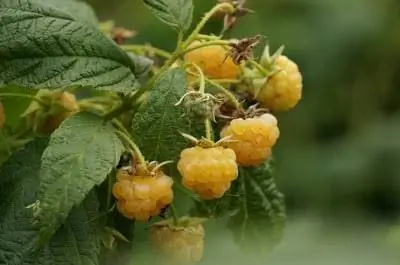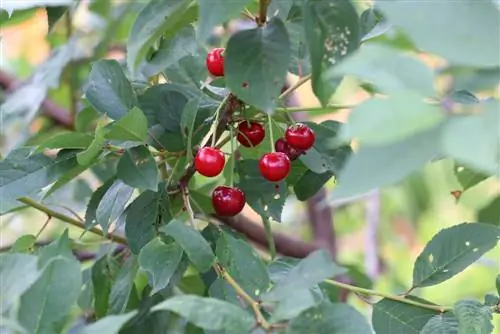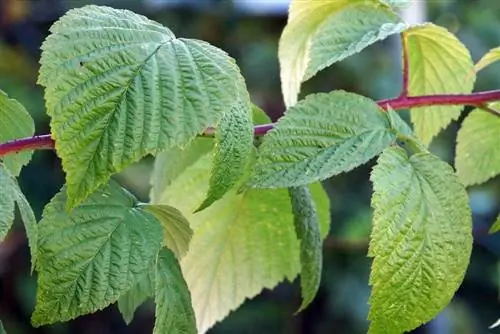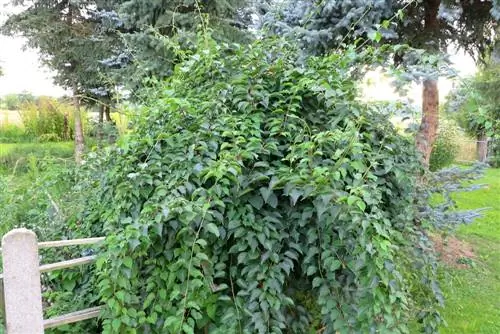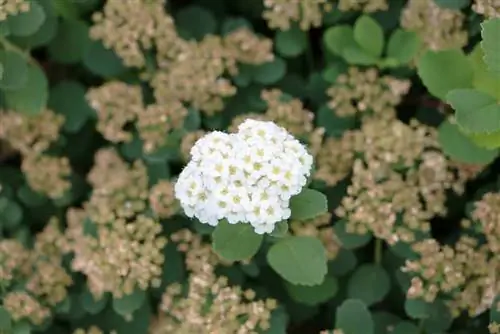- Author admin [email protected].
- Public 2023-12-17 03:39.
- Last modified 2025-01-24 12:45.
Raspberry care, planting and cutting - everything is quite easy to do with raspberries as a native plant; But even experienced gardeners sometimes benefit from an overview that lists the special wishes of a plant species. There are special requests from raspberries, but for the most part they are not difficult to fulfill. Even the often feared complicated pruning of summer raspberries and autumn raspberries becomes very easy if you know the growth characteristics of normal raspberries (=summer raspberries) and can classify the different growth behavior of the “extreme cultivation of autumn raspberries”.
Planting a raspberry bush
Raspberry bushes are basically planted like all normal native trees. For beginners in raspberry cultivation, there are detailed instructions in the article “Planting raspberries - this is how you plant raspberry plants”. Compared to the “average tree”, raspberry plants have the following special requirements:
- Location: Protected from the wind, in light shade
- Soil: Slightly acidic, moist, preferably containing clay
- Soil density: Loose and well-drained
- Water storage capacity of the soil: Not too pronounced, raspberries quickly suffer in waterlogged soil
- Soil preparation: Mix in mature compost and possibly stone dust
- Soil surface: Should be cleared of competing vegetation (some time before planting) and covered with a layer of mulch
- Nutrient and humus content: “The higher, the raspberry”, nutrient levels increased by synthetic fertilizers do not count
The following should be noted during the planting process:
- Raspberry roots are sometimes very fine and must be kept constantly moist before planting
- Don’t place raspberries too close together
- Distance from plant to plant: 40 to 60 cm
- Distance from row to row: 1, 20 if the floor is barely walked on
- If the floor is constantly walked on, the distance should be at least 1.60 m due to compaction under the walkway
- Raspberries are mostly shallow-rooted and are also planted shallowly, covering roots by 5 cm with soil
- Check whether plant pruning is necessary, if necessary shorten the rods in the upper area accordingly
- After planting, water heavily and mulch approx. 5 cm high
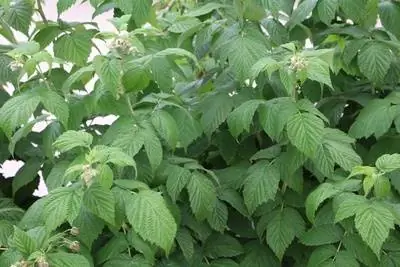
The cultivated varieties usually need a support; in nature, raspberry plants develop extremely flexible canes over two meters long, which are covered with fruit over a large part of their length. The cultivars usually called summer raspberries in the trade, which emulate normal raspberries, also develop these canes in the garden and often produce giant (tasteless) raspberries on them, which force the canes towards the ground. Since it is not good for fruits in general (and especially giant raspberries that contain a lot of water) to lie around on damp ground, these fruits need to be supported. You can already place or tie the one-year-old canes around the crossbars of the support, as the growth habit of the cane suggests. Autumn raspberries (see below) grow lower than real raspberries and usually do not need a scaffold, but can be used, for example. B. can be grown on a trellis for decorative reasons.
Speaking of cultivars
If you want to harvest real raspberry flavor, you should only plant a cultivar whose fruits you have tasted before. Maybe with friends/neighbors, then there is often an offshoot (whether it automatically has to be full of fungi and viruses or whether the corresponding media reports are hidden sales promotions for garden centers is up to you to judge). Some organic nurseries also know where tasty cultivars such as the 'Yellow Antwerp' (first mentioned around 1800, the oldest European raspberry variety) can be tried in ice cream or jam, but they may also simply advise planting original wild raspberries.
Care for the raspberry bush
Raspberries thrive with normal tree care and enjoy the following special treatment:
- 80% of raspberries look for water and nutrients just below the surface of the earth
- Therefore, do not remove weeds from the root area around the plant by hoeing
- Food competitors are hindered by the layer of mulch, which keeps the soil under the raspberries moist
- Suitable mulches: comfrey, fern, rock dust, grass clippings (not alone), semi-rotted leaf compost, coniferous wood compost, straw
- The mulch layer applied during planting remains in place at all times and provides the raspberries with a kind of permanent fertilizer (for more information see “Fertilizing raspberries properly”)
- The portion that does not rot quickly enough should be renewed annually (autumn or spring, not summer)
- Cultivated raspberries often do not develop very stable rods that need support
- Cultivation is possible as a raspberry hedge on a wire trellis with horizontal tension wires (3-4, up to a height of 1.5 m)
- This already describes the minimum requirements for a support for “weak-legged” raspberry rods
- Which doesn't mean you can't read dozens of instructions on how to build a raspberry trellis
- Separate instructions for each material (metal, wood, plastic), well-written, small, useful espalier building compendiums
- you don't need it if the raspberries can grow along a fence
- Smooth rods are only placed around the support wire, stubborn rods are tied up
- Fertilize lightly in spring when budding
- With organic berry fertilizer, mature compost, wood ash or seasoned manure
- On virus-prone (non-resistant) raspberries, control aphids that can transmit the raspberry mosaic virus
Cutting raspberries
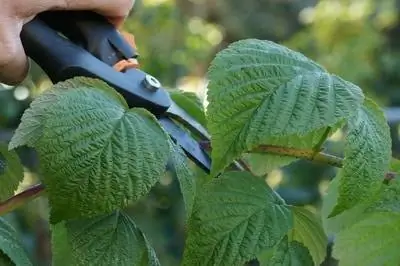
Definitely recommended for cultivated varieties, right from the start. First of all, a little raspberry botany, which will help you understand the recommendations for pruning raspberries much better:
The raspberry belongs to the rose family and within this to the genus Rubus. Not a genus for headlines: In contrast to the sister genera Malus (apples), Pyrus (pears), Prunus (cherries and plums) and Rosa (roses), the Rubus have not even had their own German name; it is just the genus of blackberries and raspberries. This is a genus that is as diverse as it is promising: 1,568 species have currently been confirmed and produce fruit almost worldwide. Where not, it is difficult to imagine, there is also a Rubus arcticus; “To get to know” here is the link to the page with the 212 Rubus species that grow in Schleswig-Holstein: www.rubus-sh.de.
The nice thing about Rubus is that all the berries of Rubus species that we have tasted so far are edible and many of them are simply delicious, like those of the raspberry plant Rubus idaeus. This raspberry plant, together with several other Rubus species, has developed a very special life form for which botanists (beyond tree and shrub etc.) had to define the separate woody plant category “mock shrub”. If you know how this way of life works (how the false bush grows), the danger of cutting away the fruit of the next season or the season after that is averted once and for all:
In nature, raspberries only bloom and fruit the year after germination (which occurs in spring). Since the pseudo-shrub does not push up woody shoots, but rather shoot shafts from the rhizome, the entire shoot shaft harvested by people or birds (the fruit branch, also known as the “rod”) dies in the winter after the fruit ripens. In the spring of last season, the raspberries had already grown the next shoots that will bear the harvest next season - and so on and so on, an ongoing all-round renewal.
Raspberries that grow in this normal rhythm are now often called “summer raspberries” as a cultivar (because an autumn raspberry was bred, which we’ll get to in a moment). But they are normal raspberries, wild raspberries also grow like this; The name came about in a similar way to how our standard time became “winter time” with the introduction of summer time.
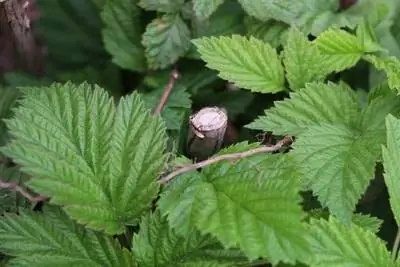
With this knowledge, the “summer raspberries” are easy to prune:
- If you planted in spring, some “early maturing” cultivars produce a few flowers in the same season
- In the season after planting, you should better remove these flowers, the plant should just grow
- Sounds like giving up, but the following year brings a relatively larger harvest
- This “normal raspberry” blooms in spring and produces berries in July to August
- The canes that bore this crop would die the following winter
- It is often recommended to remove the harvested canes immediately after harvesting
- Certainly possible, but plants usually absorb nutrients from dying plant parts
- • These canes also give the plant a little extra winter protection in the winter
- And they offer beneficial insects such as predatory mites a safe place to overwinter
- It is therefore sufficient if you remove the harvested canes in the spring before budding
- Then they can be collected more or less easily
- With a little trimming, the harvested canes should be removed close to the ground
- The annual canes are allowed to continue to grow so that they bear fruit next year
- If they “shoot” too eagerly but rather thinly, they can be shortened to about two meters
- In the spring the next floating rods will be thinned out
- With 7-10 strong canes of one vintage per linear meter, raspberries produce best
Tip:
The harvested canes may only be left over the winter on raspberries that have been continually thinned out and grow accordingly loose and airy. If this is not the case, the growth of the next generation of canes will quickly make the raspberry too dense and then allowing the old/too many of the old canes to overwinter would encourage the spread of fungal diseases. The plants that are best protected from fungi are those that are well ventilated by the wind between the rods.
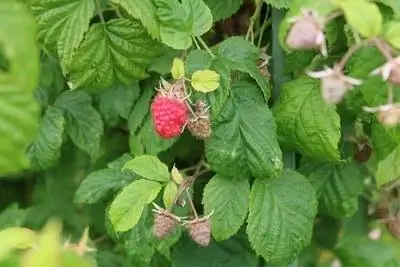
The autumn raspberries are a breeding attempt to modify the raspberry harvest, according to raspberry experts, with a result of dubious value:
- They are bred for “remontant” and particularly late flowering and fruiting
- These “autumn raspberries” can be harvested from the end of summer until the first frost
- The harvest begins in the first year because autumn raspberries fruit on annual wood
- The reason is unknown, it is probably difficult to get canes that are only fruiting in the second year to be replaced
- The raspberries were genetically completely “mixed up” by the breeders
- Instead of letting the fruit rod ripen for a season, it grows straight away on fresh wood
- This is not necessarily intended to help bring more raspberry flavor to the fruit
- Berries also develop sweetness and aroma in the sunshine
- And that is in short supply in autumn, by nature
- In many German gardens, the low position of the sun in autumn ensures increasing shading
- That's why autumn raspberries, even from the main harvest, are often not raspberry flavor bombs
- Depending on the time of planting, it is better for the overall harvest to cut off the flowers in the first season
- Once the autumn raspberries have been harvested, they can be cut back completely
- Here you have the choice again: cut immediately after harvest or in spring
- The autumn raspberries are more at risk of fungal attack due to the weather, so they need to be thinned out even more carefully
- Compromise: Some worn and cut rods are left over the winter for the beneficial insects
- In spring they are removed before budding so that the autumn raspberries sprout completely again
In both cases, repruning may be necessary during the season because canes that have already been shortened grow as stubs out of the ground or the base or because young shoots become sick and weak. A little pruning is necessary every season if you notice that the raspberry plant is producing twisted canes and/or is growing densely, promoting disease. If the raspberry has become too large overall, it can be shortened at the top and all around after the first fall (immediately afterwards so that it can still seal the cut until the first frost). Incidentally, this frost can creep up to 40 cm into the raspberry's veins, so the raspberry's skeleton should contain many significantly longer shoots of around 1 m even after cutting.
Tip:
It is sometimes recommended to only cut away the harvested canes of autumn raspberries to the extent that they were covered with fruit and otherwise simply let them continue to grow next spring. Because then the autumn raspberries “remember” that their species actually bears fruit on canes that have already ripened for a season and in the summer, and show exactly this behavior. However, they don't seem to remember it exactly, because all the reports from gardeners who have tried it complain about the bland, meaningless taste of this little premature additional harvest. The main harvest in autumn is said to be weakened by the early harvest, so autumn raspberries are more theoretical than practical - you should save yourself “cutting design for the purpose of an additional summer harvest” and cut the autumn raspberries back completely after the harvest.

